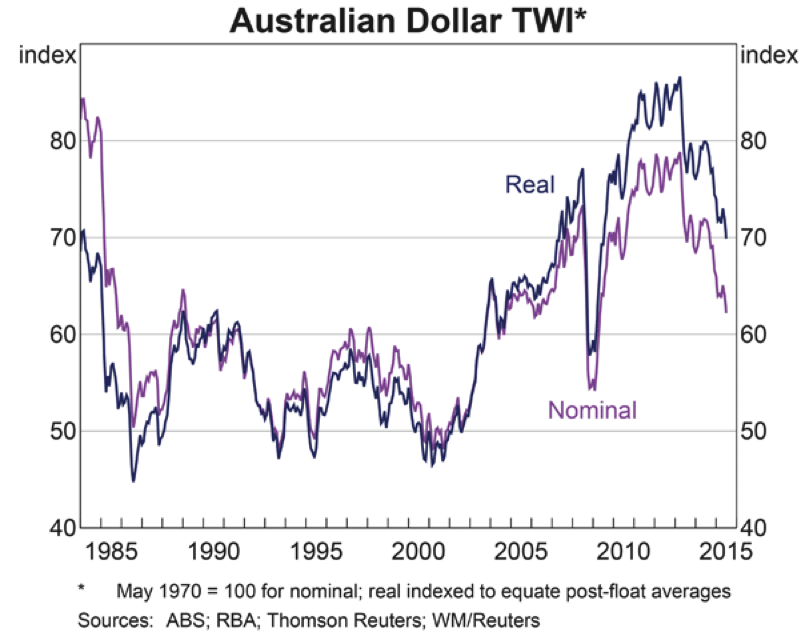Every commentator around the country has noticed an intriguing change of language from the Reserve Bank of Australia when it comes to the Australian dollar. But by my reckoning, the implications of this change have been largely misinterpreted.
Indeed, I suspect the RBA would not be surprised were the $A to fall further, but it is less anxious that it should.
For starters, let’s recall how the RBA has been referring to the $A up until recently. In the statement following the July policy meeting, the RBA indicated “further depreciation [in the $A] seems both likely and necessary, particularly given the significant declines in key commodity prices.”
Fast forward to the August policy statement, and the RBA now suggests “the Australian dollar is adjusting to the significant declines in key commodity prices.”
Wow! The Bank has changed its wording. But what does it mean?
At face value, some analysts have suggested the RBA is now happy with the $A’s level, and it less keen for it to fall further. That in turn suggests it’s less likely to cut interest rates.
I think the RBA’s view is a little more subtle than that.
By arguing the $A “is adjusting” rather than say, “has adjusted’, the RBA still views the $A’s behaviour as still evolving to the fundamentals. Relative to where commodity prices and relative interest rates are today, the RBA now feels the $A is finally closer to “fair-value” than it has been for a while – so further depreciation simply to have the $A reflect current fundamentals is unlikely and unnecessary.
That said, where the $A goes from here still depends on how the fundamentals evolve. The good news is that the $A has finally done what is had always done in the past – adjust to levels more reflective of underlying fundamentals. That’s why it was floated in the first place, and its recent behaviour is testament to the value of having it be set in a competitive market place.
The floating to the $A probably remans the single greatest economic reform in Australia in the post-war period.
If commodity prices broadly stabilise at today’s current levels, and the United States does not raise interest rates too far too fast, fundamentals would suggest the $A does not need to fall a lot further – and the RBA would not be too unhappy if it did not.
As the RBA is open minded over whether commodity price will fall a lot more, its open minded over whether the $A needs to either.
But if commodity prices do fall further, then the RBA would still naturally expect the $A to follow suit. Indeed, the $A’s behaviour of late has given the RBA more confidence that the $A has and will react to evolving fundamentals.
Of course, that begs the question: can commodity prices fall further? Even at around US$50/tonne, spot iron ore prices are a lot lower than they were during the commodity price boom, but still more than twice as high as the $20/tonne level prevailing under long-term contracts prior to the China boom. They could easily fall further, especially as high cost Chinese producers seem reluctant to exit the market as quickly as many commentators once assumed. It is also the case that major producers have been able to slash costs, meaning they remain profitable at lower price levels.
Bigger picture, as we all know, Chinese economic growth is slowing, and the supply of iron ore is (belatedly) still rising. To economists, this is the classic “cob-web” model, where supply is only able to react with a lag to earlier demand and price levels. Just as suppliers were to slow to raise production when Chinese demand was booming – which led to stratospheric price gains – they are now boosting supply at precisely the wrong time, and will be too slow to react to slowing demand and weaker prices.
It’s why commodity prices are inherently volatile – and tend to over and undershoot the market clearing level of prices over the cycle.
As with commodity prices, so to the $A. The $A is not always well behaved and can also tend to overshoot and undershoot its “fundamental” level over the cycle – as we’ve recently seen.
I’d also note that Australia wage costs grew more quickly than those of our major trading partners during the mining boom – which, along with commodity price and low global interest rates, helped push up the “real” exchange rate to above-average level.

Even at today’s nominal $A levels, the “real” exchange rate is still somewhat above its long-run average (at today’s prices) of around US66c. So we need to get to US66c, just to restore the $A to its long-run “average” real level in the post-float era.
And that would only be “average”, not the well below-average levels we might to seriously boost growth in the non-mining trade sectors that were devastated by the “Dutch disease” during the mining boom.
Some industries – like car making – will never return. And so-called export “hysteresis” effects (whereby it takes a big price change to re-start investment in intensive industries) add to the case for the $A falling further. More nimble smaller services operators in the tourism and education sectors are already starting to feel the benefit of a weaker $A.
All up, however, the RBA’s change of wording does not necessarily suggest the RBA does not want to see the $A fall further. Rather it’s a recognition of the fact the $A is now finally responding to fundamentals, and we might expect this to continue into the future. I expect those fundamental to remain negative for a while yet.
From an investment perspective, that still suggests remaining short the $A and long local stocks exposed to foreign earnings. It also suggest retaining good exposure to international markets on an unhedged currency basis, as is now very easy to achieve through locally traded exchange traded funds (ETFs.)






